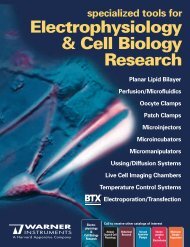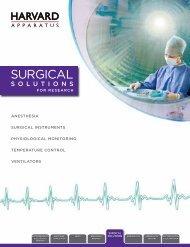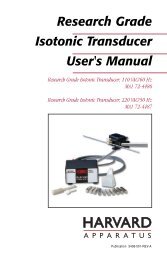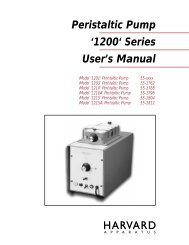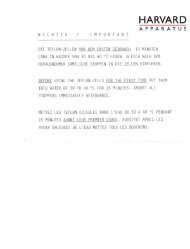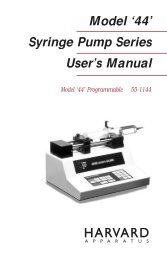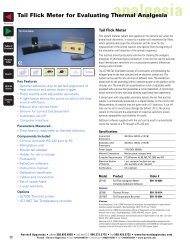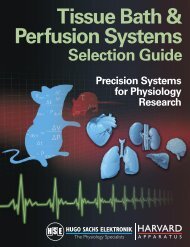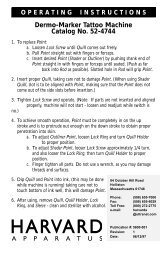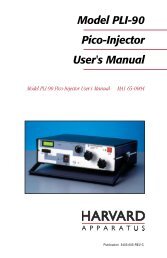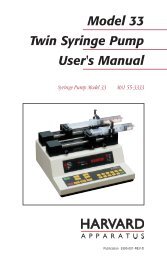Guide to Ussing Chamber Systems - Harvard Apparatus
Guide to Ussing Chamber Systems - Harvard Apparatus
Guide to Ussing Chamber Systems - Harvard Apparatus
You also want an ePaper? Increase the reach of your titles
YUMPU automatically turns print PDFs into web optimized ePapers that Google loves.
<strong>Ussing</strong> <strong>Chamber</strong>s <strong>Systems</strong> From Warner<br />
Overview<br />
An <strong>Ussing</strong> System, used <strong>to</strong> measure transport across epithelial membranes, is generally comprised of a chamber and perfusion system, and, if needed,<br />
an amplifier and data acquisition system. The heart of the system lies in the chamber with the other components performing supporting roles. The<br />
‘Classic’ chamber design, first introduced by the Danish physiologist Hans <strong>Ussing</strong> in the early 1950’s, is still in wide use <strong>to</strong>day. However, several newer<br />
designs are now available that optimize for convenience and for diffusion- or electrophysiology-based measurements.<br />
Epithelia are polar structures possessing an apical (or mucosal) and basolateral (or serosal) side. It is the movement of electrolytes, non-electrolytes, and<br />
H 2 O across this membrane that is of interest <strong>to</strong> the researcher. <strong>Ussing</strong> systems have been used <strong>to</strong> make measurements from native tissue including<br />
s<strong>to</strong>mach, large and small intestine, gall and urinary bladder, skin, and trachea, as well as from tissue derived cell monolayers from various sources<br />
including renal tubes, pancreas, and salivary and sweat glands.<br />
A well designed <strong>Ussing</strong> chamber supports an epithelia membrane or cell monolayer in such a way that each side of the membrane is isolated and faces<br />
a separate chamber-half. This configuration allows the researcher <strong>to</strong> make unique chemical and electrical adjustments <strong>to</strong> either side of the membrane<br />
with complete control.<br />
Study Types<br />
<strong>Ussing</strong> systems can be used for either electrophysiology or diffusion-based studies, or for a combination of both. They can also be used for radiotracer<br />
studies wherein the ionic species under transport is radiolabled. For convenience, we will consider radiotracer studies <strong>to</strong> operate within the context of a<br />
diffusion or electrophysiology-based system.<br />
While each approach described above makes use of a chamber and fluid handling system, an electrophysiology-based setup has the added dimension<br />
of a current and/or voltage clamp amplifier and data acquisition system. Relevant components include:<br />
Diffusion-based system<br />
•A chamber with perfusion system and tissue<br />
holding apparatus<br />
•Temperature and gas control, if needed<br />
•The ability <strong>to</strong> acquire data<br />
Electrophysiology-based system<br />
• A chamber with perfusion system and tissue<br />
holding apparatus<br />
• Temperature and gas control, if needed<br />
• Amplifier<br />
• Data acquisition system and software<br />
USSING CHAMBERS SYSTEMS FROM WARNER<br />
A <strong>Systems</strong> Approach<br />
Warner instruments offers many <strong>Ussing</strong> system components embodying several different design philosophies. Fortunately, the various components are<br />
generally interchangeable with each other (i.e., all the amps are compatible with all the chambers). While this presents the potential for a great degree<br />
of flexibility and cus<strong>to</strong>mization, it can also increase the complexity of selecting the optimum combination of <strong>Ussing</strong> system<br />
components for your needs.<br />
The goal of this article is <strong>to</strong> outline the advantages and disadvantages associated with each <strong>Ussing</strong> chamber design with an eye <strong>to</strong>wards guiding you in<br />
selecting the best components for your application.<br />
<strong>Ussing</strong> Measurements<br />
A basic understanding of different <strong>Ussing</strong> measurements commonly made can guide you in determining which components best fit your needs when<br />
building a system. As stated earlier, <strong>Ussing</strong> systems can be defined as being either diffusion or electrophysiology-based.<br />
A diffusion-based system is generally focused on measuring transepithelial fluid transport and is used <strong>to</strong> follow net movement of H 2 O or solute across the<br />
membrane. By itself, diffusion-based systems do not provide specific information regarding the underlying transport mechanism and are best suited<br />
<strong>to</strong>wards measurements of leaky epithelia characterized by electroneutral transport.<br />
While fluid transport can result in a volume change in the recording chamber, it is usually quantitated by measuring a corresponding change in a volume<br />
marker. Volume markers include changes in salt or dye concentration, or changes in physical characteristics such as fluid capacitance or resistance.<br />
Advantages of fluid transport measurements using a volume marker include good temporal resolution and sensitivity <strong>to</strong> small fluxes (volume changes as<br />
low as ±1 nl/min have been reported). A disadvantage is the requirement for small volume chambers.<br />
An electrophysiology-based system focuses on measuring transepithelial electrical responses <strong>to</strong> experimental perturbations. These systems are used <strong>to</strong><br />
quantitate the operation of electrogenic pathways in the membrane (e.g., ion pumps, channels, etc). As such, an electrophysiology-based system carries<br />
the additional hardware requirement of a voltage and/or current clamp amplifier, a data acquisition system, and collection/analysis software.<br />
Basic measurement parameters in electrophysiology-based <strong>Ussing</strong> systems include transmembrane voltage (V t ), epithelial membrane resistance (R t ), and<br />
short circuit current (I SC ; the current required <strong>to</strong> bring V t <strong>to</strong> 0 mV). A limitation with these systems is that non-electrogenic ion transport mechanisms such<br />
as fluid transport and electroneutral ion transport cannot be directly moni<strong>to</strong>red. This limitation, however, can be addressed by employing indirect or<br />
secondary measurements such as ion replacement, transport inhibition, and the use of hormones and second messengers.<br />
The use of radioiso<strong>to</strong>pe tracers is one measurement technique deserving special mention. This technique can be applied equally well <strong>to</strong> both diffusion<br />
and electrophysiology-based measurements and is usually employed <strong>to</strong> provide information regarding ion-specific transport mechanisms. For example, a<br />
diffusion-based model cannot identify the fluid being transported or if the measured volume change is the result of a hydrostatic or osmotic process. Finally,<br />
if an osmotic-driven volume change is mediated by an ionic mechanism, then the responsible ion is not identified. By comparison, a limitation with<br />
the electrophysiologybased model is that while ionic transport can be measured, the specific ion crossing the membrane is not specifically determined.<br />
This is especially true for multi-ionic salt conditions. For both cases, the use of a radiolabeled ionic species allows for directly moni<strong>to</strong>ring ion-specific<br />
translocation for the two measurement systems described above.<br />
Warner Instruments • Phone (203) 776-0664 • Toll Free U.S. (800) 599-4203 • Fax (203) 776-1278 • www.warneronline.com<br />
1



